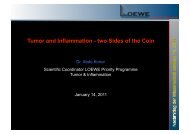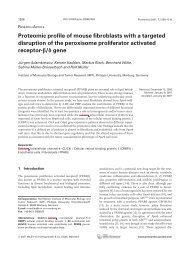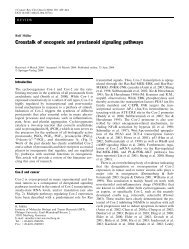Joost Gribnau - Visualization and characterization of regulators ... - IMT
Joost Gribnau - Visualization and characterization of regulators ... - IMT
Joost Gribnau - Visualization and characterization of regulators ... - IMT
Create successful ePaper yourself
Turn your PDF publications into a flip-book with our unique Google optimized e-Paper software.
<strong>Joost</strong> <strong>Gribnau</strong> - <strong>Visualization</strong> <strong>and</strong> <strong>characterization</strong> <strong>of</strong> <strong>regulators</strong> <strong>of</strong> X-inactivation<br />
Background<br />
In mammals, dosage compensation <strong>of</strong> X-linked genes is achieved by inactivation <strong>of</strong> one <strong>of</strong> the<br />
two X-chromosomes in female somatic cells. At the onset <strong>of</strong> r<strong>and</strong>om X-inactivation, around the<br />
implantation stage <strong>of</strong> the embryo, one X-chromosome is designated to remain active (Xa) <strong>and</strong> all<br />
other X-chromosomes will be inactivated (Xi). Genetic studies have revealed that silencing <strong>of</strong> the<br />
X-chromosome initiates from one location on the X-chromosome, termed the X-inactivation<br />
center (Xic). The Xist gene, which is located within the Xic, is required <strong>and</strong> sufficient for X-<br />
inactivation. Xist encodes a non-coding RNA that coats the inactive X-chromosome, thereby<br />
directly or indirectly attracting chromatin components <strong>and</strong> chromatin modifiers, which initiate<br />
<strong>and</strong> establish epigenetic changes rendering the Xi transcriptionally inactive. In most cells the Xi<br />
is visible as a dense stainable structure in the nucleus, called the Barr body. Once the X-<br />
chromosome is inactivated, this inactive state is inherited clonally through many rounds <strong>of</strong> cell<br />
division (for review see Plath 2002).<br />
The first notable change in chromatin structure on the Xi, is global tri-methylation <strong>of</strong> the lysine<br />
27 residue <strong>of</strong> histone H3 (H3-K27), which happens concomitantly with the initial Xist RNA<br />
spread along the chromosome. Accumulation <strong>of</strong> this histone modification is mediated by the<br />
Polycomb group proteins EED <strong>and</strong> Ezh2, which are transiently enriched on the Xi at the onset <strong>of</strong><br />
X-inactivation (Silva 2003, Plath 2003). EED <strong>and</strong> Ezh2 act in a complex <strong>and</strong> are also directly or<br />
indirectly required for global di-methylation <strong>of</strong> histone H3 lysine 9 (H3-K9) <strong>of</strong> Xi chromatin,<br />
which happens after the accumulation <strong>of</strong> H3-K27 tri-methylation (for review see Cohen 2002).<br />
Other chromatin modifications found to occur in the early stages <strong>of</strong> X-inactivation are global<br />
hypo acetylation <strong>of</strong> H3-K9 <strong>and</strong> hyper acetylation <strong>and</strong> hypo methylation <strong>of</strong> histone H3 lysine 4.<br />
Several other epigenetic changes happen relatively late during the X-inactivation process<br />
including global hypo acetylation <strong>of</strong> histone H4, accumulation <strong>of</strong> the histone variant<br />
macrohistone H2A <strong>and</strong> CpG isl<strong>and</strong> methylation. These later changes may be responsible <strong>and</strong><br />
sufficient for the maintenance <strong>of</strong> the silent state <strong>of</strong> the Xi in somatic cells. In addition, Brca1 has<br />
been found to colocalize with the Xi in somatic cells, but its role in the X-inactivation process is<br />
not well defined.<br />
Despite the recent progress in determining different chromatin modifications <strong>and</strong> proteins<br />
involved in the initiation, establishment <strong>and</strong> maintenance <strong>of</strong> the inactive X, little is known about<br />
the initial stages <strong>of</strong> the X-inactivation process, especially how Xist RNA silences the Xi, how<br />
Xist RNA associates with <strong>and</strong> spreads along the X-chromosome, <strong>and</strong> how the choice which X-<br />
chromosome to inactivate occurs. The X-inactivation process starts with choosing one <strong>of</strong> two<br />
identical X-chromosomes to remain active <strong>and</strong> the other one to become inactivated. In humans<br />
<strong>and</strong> mice this choice process can be skewed to some extent in which more <strong>of</strong> either the paternal<br />
or the maternal inherited X chromosomes are inactivated. The skewing process is mediated by the<br />
Xce locus, which overlaps <strong>and</strong> extends downstream <strong>of</strong> the Xist gene. In a clinical setting,<br />
skewing <strong>of</strong> X inactivation has been linked to penetrance <strong>of</strong> X-linked diseases such as Rett<br />
syndrome in heterozygous women. If an X-linked disease locus is linked to a strong Xce (which<br />
means a higher chance to remain active) compared to the wild-type X-chromosome this will<br />
result in a higher likelihood for the disease to be manifested. To date it remains unclear how the<br />
choice process is regulated. Different models explaining the choice process have been described.<br />
The prevailing model predicts a blocking factor, which binds <strong>and</strong> prevents inactivation <strong>of</strong> one <strong>of</strong><br />
the X chromosomes. The blocking factor has to be present in a sufficiently low concentration to
ensure that it will bind only one X chromosome per diploid chromosome set. A second model,<br />
the ‘transvection’ model predicts that the X chromosomes physically meet in space, cross<br />
communicate <strong>and</strong> decide which <strong>of</strong> the X chromosomes will be inactivated. The choice process<br />
may also be stochastic, in which the Xic with the highest concentration <strong>of</strong> Xist RNA will trigger<br />
silencing complex formation. Initiation <strong>of</strong> such a complex could in turn down regulate silencing<br />
on the second X chromosome. None <strong>of</strong> these models are mutually exclusive <strong>and</strong> may all to some<br />
extent contribute to the choice process.<br />
Another intriguing <strong>and</strong> unexplained part <strong>of</strong> mammalian X-inactivation is spreading <strong>of</strong> Xist RNA<br />
over the Xi. It is unclear whether Xist RNA spreads along the chromosome in a linear fashion,<br />
using chromatin entry sites, or whether it jumps along chromatin loops. Finally, although many<br />
chromatin modifications have been detected on the Xi to date none <strong>of</strong> those have been implicated<br />
in the initial silencing <strong>of</strong> the X-chromosome. Many data suggest that Xist RNA functions in<br />
association with proteins, <strong>and</strong> identifying these proteins would help to elucidate the mechanism<br />
<strong>of</strong> spreading <strong>and</strong> silencing by Xist RNA. In order to increase our underst<strong>and</strong>ing <strong>of</strong> these different<br />
processes we have established a system in which Xist RNA is tagged. The tag allows live<br />
visualization <strong>of</strong> Xist RNA, purification <strong>of</strong> Xist binding proteins, <strong>and</strong> targeting <strong>of</strong> c<strong>and</strong>idate<br />
proteins, implicated in the X-inactivation process, to Xist RNA in order to identify their role in<br />
X-inactivation.<br />
Aims<br />
The aim <strong>of</strong> my lab is to underst<strong>and</strong> the role <strong>of</strong> the chromatin remodeling complexes <strong>and</strong><br />
chromatin modifications in gene expression or silencing. We use the X-inactivation system as a<br />
model system to study these processes. We have generated Xist tagged ES cell lines. The tagging<br />
system is based on an insertion <strong>of</strong> 16 stem-loop RNA binding sites for bacteriophage MS2 coat<br />
protein into the Xist gene <strong>and</strong> simultaneous expression <strong>of</strong> a MS2 coat -fusion proteins which will<br />
bind the MS2 stemloop. Live imaging <strong>of</strong> X inactivation by tagging the Xist RNA with GFP<br />
allows temporal recording <strong>of</strong> Xist transcription, spreading <strong>and</strong> nuclear localization on a cellular<br />
level <strong>and</strong> could shed new light on our underst<strong>and</strong>ing <strong>of</strong> this process. In addition, the use <strong>of</strong> Xist<br />
tagged cell lines to target putative <strong>regulators</strong> <strong>of</strong> X inactivation or specific chromatin modifiers to<br />
the Xi provides a powerful tool to elucidate their individual role in X inactivation or chromatin<br />
remodeling in general. The robustness <strong>and</strong> uniformity <strong>of</strong> histone modifications on the Xi provides<br />
a convenient readout for detecting chromatin changes. MS2 tagged Xist ES cells are also a potent<br />
platform for protein purification <strong>and</strong> may help identify new players in the X inactivation process.<br />
Publications <strong>of</strong> the last 5 years<br />
<strong>Gribnau</strong>, J., Luikenhuis, S., Hochedlinger, K., Monkhorst, K. <strong>and</strong> Jaenisch, R. (2005) X chromosome choice occurs<br />
independently <strong>of</strong> asynchronous replication timing. J Cell Biol, 168, 365-373.<br />
Geijsen, N., Horoschak, M., Kim, K., <strong>Gribnau</strong>, J., Eggan, K. <strong>and</strong> Daley, G.Q. (2004) Derivation <strong>of</strong> embryonic germ<br />
cells <strong>and</strong> male gametes from embryonic stem cells. Nature, 427, 148-154.<br />
<strong>Gribnau</strong>, J., Hochedlinger, K., Hata, K., Li, E. <strong>and</strong> Jaenisch, R. (2003) Asynchronous replication timing <strong>of</strong> imprinted<br />
loci is independent <strong>of</strong> DNA methylation, but consistent with differential subnuclear localization. Genes Dev, 17,<br />
759-773.<br />
Singh, N., Ebrahimi, F.A., Gimelbrant, A.A., Ensminger, A.W., Tackett, M.R., Qi, P., <strong>Gribnau</strong>, J. <strong>and</strong> Chess, A. (2003)<br />
Coordination <strong>of</strong> the r<strong>and</strong>om asynchronous replication <strong>of</strong> autosomal loci. Nat Genet, 33, 339-341.<br />
Biniszkiewicz, D., <strong>Gribnau</strong>, J., Ramsahoye, B., Gaudet, F., Eggan, K., Humpherys, D., Mastrangelo, M.A., Jun, Z.,<br />
Walter, J. <strong>and</strong> Jaenisch, R. (2002) Dnmt1 overexpression causes genomic hypermethylation, loss <strong>of</strong> imprinting,<br />
<strong>and</strong> embryonic lethality. Mol Cell Biol, 22, 2124-2135.<br />
Simon, I., Tenzen, T., Mostoslavsky, R., Fibach, E., L<strong>and</strong>e, L., Milot, E., <strong>Gribnau</strong>, J., Grosveld, F., Fraser, P. <strong>and</strong> Cedar,<br />
H. (2001) Developmental regulation <strong>of</strong> DNA replication timing at the human beta globin locus. Embo J, 20, 6150-<br />
6157.
Akbarian, S., Chen, R.Z., <strong>Gribnau</strong>, J., Rasmussen, T.P., Fong, H., Jaenisch, R. <strong>and</strong> Jones, E.G. (2001) Expression<br />
pattern <strong>of</strong> the Rett syndrome gene MeCP2 in primate prefrontal cortex. Neurobiol Dis, 8, 784-791.<br />
Ristaldi, M.S., Drabek, D., <strong>Gribnau</strong>, J., Poddie, D., Yannoutsous, N., Cao, A., Grosveld, F. <strong>and</strong> Imam, A.M. (2001) The<br />
role <strong>of</strong> the -50 region <strong>of</strong> the human gamma-globin gene in switching. Embo J, 20, 5242-5249.<br />
Whyatt, D., Lindeboom, F., Karis, A., Ferreira, R., Milot, E., Hendriks, R., de Bruijn, M., Langeveld, A., <strong>Gribnau</strong>, J.,<br />
Grosveld, F. <strong>and</strong> Philipsen, S. (2000) An intrinsic but cell-nonautonomous defect in GATA1-overexpressing<br />
mouse erythroid cells. Nature, 406, 519-524.<br />
<strong>Gribnau</strong>, J., Diderich, K., Pruzina, S., Calzolari, R. <strong>and</strong> Fraser, P. (2000) Intergenic transcription <strong>and</strong> developmental<br />
remodeling <strong>of</strong> chromatin subdomains in the human beta-globin locus. Mol Cell, 5, 377-386.



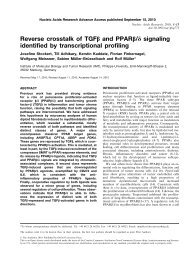


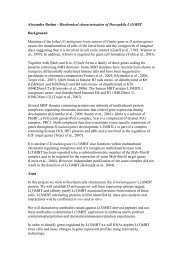
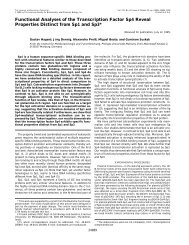
![2-(2-Bromophenyl)-3-{[4-(1-methyl-piperazine)amino]phenyl}](https://img.yumpu.com/22645635/1/190x248/2-2-bromophenyl-3-4-1-methyl-piperazineaminophenyl.jpg?quality=85)
